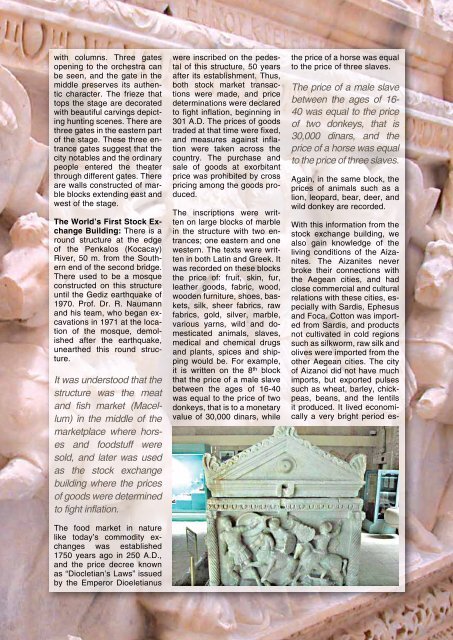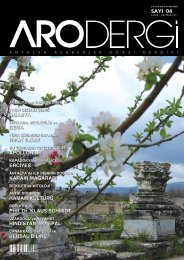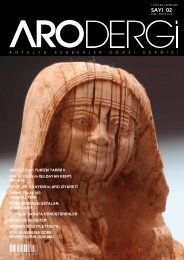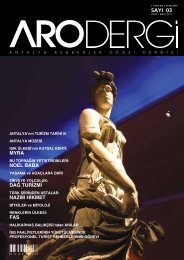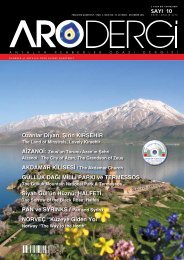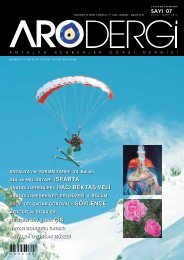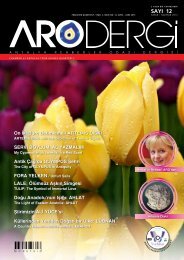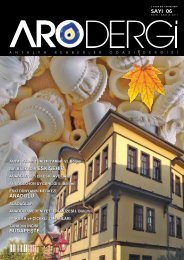AizanoiBatı ve doğu olmak üzere ikigirişi bulunan yapıda yazıtlarbüyük mermer bloklar üzerineyazılmıştır. Metinler Latince veGrekçe olarak yazılıydı. Bloklarüzerine meyve, post, kürk,deri eşyalar, örgü, ahşap, ahşapeşyalar, ayakkabı, sepet,ipek, saf kumaş, ham kumaş,altın, gümüş, mermer, çeşitliiplikler, yabani ve evcil hayvan,köle, tıbbi ve kimyevi ilaçlarve bitkiler, baharat ve nakliyatücretlerinin ne kadar olacağıbelirtilmiştir. Örneğin 8. Blokta,16 ila 40 yaşları arasında birerkek kölenin, iki eşeğin ücretineyani 30.000 dinara, bir atınise üç köle ücretine eşit olduğuyazmaktadır.16 ila 40 yaş arası bir erkekköle, iki eşeğin ücretineyani 30.000 dinara; bir atise üç köle ücretine eşitti.Yine aynı blokta, aslan, leopar,ayı, geyik, yabani eşek gibihayvanların da ücretlerindensöz edilmektedir.Borsa binasındaki bu bilgilersayesinde, Aizanoi’nin yaşamşartları hakkında da bilgi edinmişoluyoruz. Aizanoililer Egekentleriyle bağlarını hiç kopartmamışlar,başta Sardes, Efesve Foça gibi kentlerle ticari vekültürel ilişkilerini yakın tutmuşlardır.Sardes’ten pamuk,diğer Ege kentlerinden ipekböceği, ham ipek ve zeytin gibisoğuk bölgede yetişmeyenürünlerin ithalatı yapılmıştır.Aizanoi kentinin çok fazla dışaalımı olmamış ve ürettiği buğday,arpa, nohut, fasulye, mercimekgibi bakliyat ürünleriniihraç etmiştir.Özellikle Roma dönemindeiklime uygun yetiştirdikleri tarımürünleri; şarap, peynir gibiendüstriyel ürünler ve deri,kürk, yün iplik, ayakkabı gibibirçok imalat malları sayesindeekonomik olarak çokparlak bir dönem yaşamıştır.Ayrıca nakliye amaçlı arabalarınve tarım araçlarının daimalatının yapıldığını ve nakliyeişlerinin de özel şahıslartarafından yapılıyor olduğunuBorsa Binası’nın yazıtlarındabelirtilen “Nakliye TavanÜcretleri”nden anlıyoruz.Sütunlu Cadde ve Dükkanlar:1970 Gediz depremindeyıkılan ilkokul binasının temizlenmesisırasında, borsa binasınıngüney bitişiğine düşensütunlu bölümde bir takım anıtsaltaşlara rastlanmıştır. 1992-1995 yılları arasında AlmanArkeoloji Enstitüsü adına kazıbaşkanı K. Rheidt burada kazılarabaşlar ve etrafı sütunlarladonatılmış, ortasında mermerkaplı, yanlarda ise dükkanlarıbulunan 450 m uzunluğundabir yol ortaya çıkartır. Bu sütunlucaddenin, tapınak tarafınaolan bağlantısının ahşapbir köprü ile sağlandığı düşünülmektedir.Klaus Rheidt veekibinin restorasyonu sonucu,sütunlar ve bulunan parçalaryerlerine konulmuştur.Ayrıca; bu ekip tarafından bulunup,parçaları birleştirilenmermerden yapılmış, flüt çalanpanter postlu, çıplak birSatyr heykeli de bugün KütahyaArkeoloji Müzesi’nde sergilenmektedir.Sütunlu caddenininşası sırasında, o dönemdeAizanoi’de terk edilen binalardanve hatta yıkılmış olan ArtemisTapınağı’ndan getirilenparçaların yapı malzemesi olarakkullanıldığı görülmüştür.Tanrıça Artemis’in ve tapınağıarmağan eden Asklepiades’inadından söz eden yazıt daburadadır. Bu görkemli sütunlucaddenin MS VI. yüzyılınortalarına kadar ayakta kaldığıve bölgenin fay hattına 20km uzakta olmasından dolayı,depremler sonucu yıkıldığı anlaşılmaktadır.Köprüler ve Taşkın ÖnlemeBarajı / Köprüsü:Muhteşem Aizanoi kentinin bazıyapılarının halen ayakta ve kullanılabileceksağlamlıkta olmasıbu kentin mühendislerinin matematik,statik ve hidrodinamikgibi birçok bilim dalındaki üstünyeteneklerinin ürünüdür. PenkalasIrmağı’nın ıslahı yapılmış,mermer ve ahşap olmak üzereköprüler inşa edilmişti. Bu mermerköprülerden ikisi bugün bilegeçişi sağlamaktadır. En önemliköprülerden biri de ırmaktaoluşacak taşkınları önlemeyeyönelik baraj özelliği sağlayanköprüdür. Penkalas Irmağı’nınşehir içinden geçişi her iki yakasınairi kesme taşlarla duvarlarörülerek kanalize edilmiş.80>81 ANTALYA REHBERLER ODASI DERGİSİ
with columns. Three gatesopening to the orchestra canbe seen, and the gate in themiddle preserves its authenticcharacter. The frieze thattops the stage are decoratedwith beautiful carvings depictinghunting scenes. There arethree gates in the eastern partof the stage. These three entrancegates suggest that thecity notables and the ordinarypeople entered the theaterthrough different gates. Thereare walls constructed of marbleblocks extending east andwest of the stage.The World’s First Stock ExchangeBuilding: There is around structure at the edgeof the Penkalos (Kocacay)River, 50 m. from the Southernend of the second bridge.There used to be a mosqueconstructed on this structureuntil the Gediz earthquake of1970. Prof. Dr. R. Naumannand his team, who began excavationsin 1971 at the locationof the mosque, demolishedafter the earthquake,unearthed this round structure.It was understood that thestructure was the meatand fish market (Macellum)in the middle of themarketplace where horsesand foodstuff weresold, and later was usedas the stock exchangebuilding where the pricesof goods were determinedto fight inflation.The food market in naturelike today’s commodity exchangeswas established1750 years ago in 250 A.D.,and the price decree knownas “Diocletian’s Laws” issuedby the Emperor Dioeletianuswere inscribed on the pedestalof this structure, 50 yearsafter its establishment. Thus,both stock market transactionswere made, and pricedeterminations were declaredto fight inflation, beginning in301 A.D. The prices of goodstraded at that time were fixed,and measures against inflationwere taken across thecountry. The purchase andsale of goods at exorbitantprice was prohibited by crosspricing among the goods produced.The inscriptions were writtenon large blocks of marblein the structure with two entrances;one eastern and onewestern. The texts were writtenin both Latin and Greek. Itwas recorded on these blocksthe price of: fruit, skin, fur,leather goods, fabric, wood,wooden furniture, shoes, baskets,silk, sheer fabrics, rawfabrics, gold, silver, marble,various yarns, wild and domesticatedanimals, slaves,medical and chemical drugsand plants, spices and shippingwould be. For example,it is written on the 8 th blockthat the price of a male slavebetween the ages of 16-40was equal to the price of twodonkeys, that is to a monetaryvalue of 30,000 dinars, whilethe price of a horse was equalto the price of three slaves.The price of a male slavebetween the ages of 16-40 was equal to the priceof two donkeys, that is30,000 dinars, and theprice of a horse was equalto the price of three slaves.Again, in the same block, theprices of animals such as alion, leopard, bear, deer, andwild donkey are recorded.With this information from thestock exchange building, wealso gain knowledge of theliving conditions of the Aizanites.The Aizanites neverbroke their connections withthe Aegean cities, and hadclose commercial and culturalrelations with these cities, especiallywith Sardis, Ephesusand Foca. Cotton was importedfrom Sardis, and productsnot cultivated in cold regionssuch as silkworm, raw silk andolives were imported from theother Aegean cities. The cityof Aizanoi did not have muchimports, but exported pulsessuch as wheat, barley, chickpeas,beans, and the lentilsit produced. It lived economicallya very bright period es-
- Page 1 and 2:
PUBLISHED QUARTERLY, YEAR: 3, ISSUE
- Page 3 and 4:
Yeni Yıl, Yeni Bakan24 Ocak’ta
- Page 5 and 6:
Merhaba Sevgili Okurlar,Acısıyla,
- Page 7 and 8:
A Hidden City in Cilicia:The ANCIEN
- Page 9 and 10:
used in the construction of thissma
- Page 11 and 12:
Zengin içecek çeþitleri,Damak ta
- Page 13 and 14:
ehind and move on for about500 m.,
- Page 16 and 17:
Yüz Yıllık Destan: Hamidiye Kruv
- Page 18 and 19:
Hamidiye Kruvazörü ve Hüseyin Ra
- Page 20 and 21:
Hamidiye Kruvazörü ve Hüseyin Ra
- Page 22 and 23:
Hamidiye Kruvazörü ve Hüseyin Ra
- Page 24 and 25:
Hamidiye Kruvazörü ve Hüseyin Ra
- Page 26 and 27:
Hamidiye Kruvazörü ve Hüseyin Ra
- Page 28:
Hamidiye Kruvazörü ve Hüseyin Ra
- Page 31 and 32: HÜSEYİN RAUF ORBAYOsmanlı İmpar
- Page 33 and 34: Yýllýk olarak tahmini uluslararas
- Page 35 and 36: www.adnansayki.comBOSPHORUS LARASey
- Page 38 and 39: Kapadokya’nınTarih ÖncesiYrd. D
- Page 40 and 41: Doğu Akdeniz gibi Anadoludışınd
- Page 42 and 43: Kapadokya’nın Tarih Öncesi / Th
- Page 44 and 45: Kapadokya’nın Tarih Öncesi / Th
- Page 46: Kapadokya’nın Tarih Öncesi / Th
- Page 49 and 50: were found in the settlementof Guve
- Page 51 and 52: the Early Bronze Age, is calledCapp
- Page 53 and 54: Those Who Give Sound to the Earth,T
- Page 55 and 56: M. Emin Bolat was born in Iskenderu
- Page 57 and 58: “Kapadokya”DERVÝÞ EVÝGöreme
- Page 59 and 60: Our Thracian Countryman: ORPHEUSSul
- Page 61 and 62: lyre that the wild animalswould get
- Page 63 and 64: Persephone and of Orpheus’Eurydic
- Page 65 and 66: CANKURTARANHALIHayatDokundukçaGüz
- Page 67 and 68: The DoradoAtilla Sukru NILGUN, Tour
- Page 69 and 70: land of Malta. The largest catchesc
- Page 71 and 72: Dostlarla Bir MolaCAFE MOLABon Appe
- Page 73 and 74: dolu’yu, Doğu Akdeniz kıyılar
- Page 75 and 76: Aizanoi: The City of Azan,The Grand
- Page 77 and 78: the corridors of the bath andhere,
- Page 79: Türk mutfaðýnýn yöresel yemekl
- Page 83 and 84: pecially during the Romanperiod due
- Page 85 and 86: GRAFÝK TASARIM - WEB TASARIM - ARA
- Page 87 and 88: pedestrians.It is written on the in
- Page 89 and 90: logical Museum of Kutahya,and see t
- Page 91 and 92: Aspendos - Part 4T. M. P. DUGGANDue
- Page 93 and 94: was employed in the design ofthis e
- Page 96 and 97: AspendosFotoğraf: Halil Arıkanbun
- Page 98 and 99: Aspendostürülmesinin muhtemelen12
- Page 100 and 101: Dubai:Ortadoğu’nun Parlayan Yıl
- Page 102 and 103: Dubai: Ortadoğu’nun Parlayan Yı
- Page 104: Dubai: Ortadoğu’nun Parlayan Yı
- Page 107 and 108: Dubai, gece görünüm / Night View
- Page 109 and 110: 2012 Yılı Seminerlerini Tamamlad
- Page 111 and 112: ARO Eğitim GezileriDöşemealtı v
- Page 113 and 114: ARO Söyleşileri Devam Ediyor...08
- Page 115 and 116: Basında ARO
- Page 117 and 118: ARO EtkinlikleriÜyelerimize Yönel
- Page 119 and 120: SANCAKTAROÐLUSÝGORTA“Keþke”
- Page 121 and 122: Yukarıdan Aşağıya:1. Ağaç dir
- Page 123 and 124: Hastalýkta saðlýkta...Tel: +90 3


